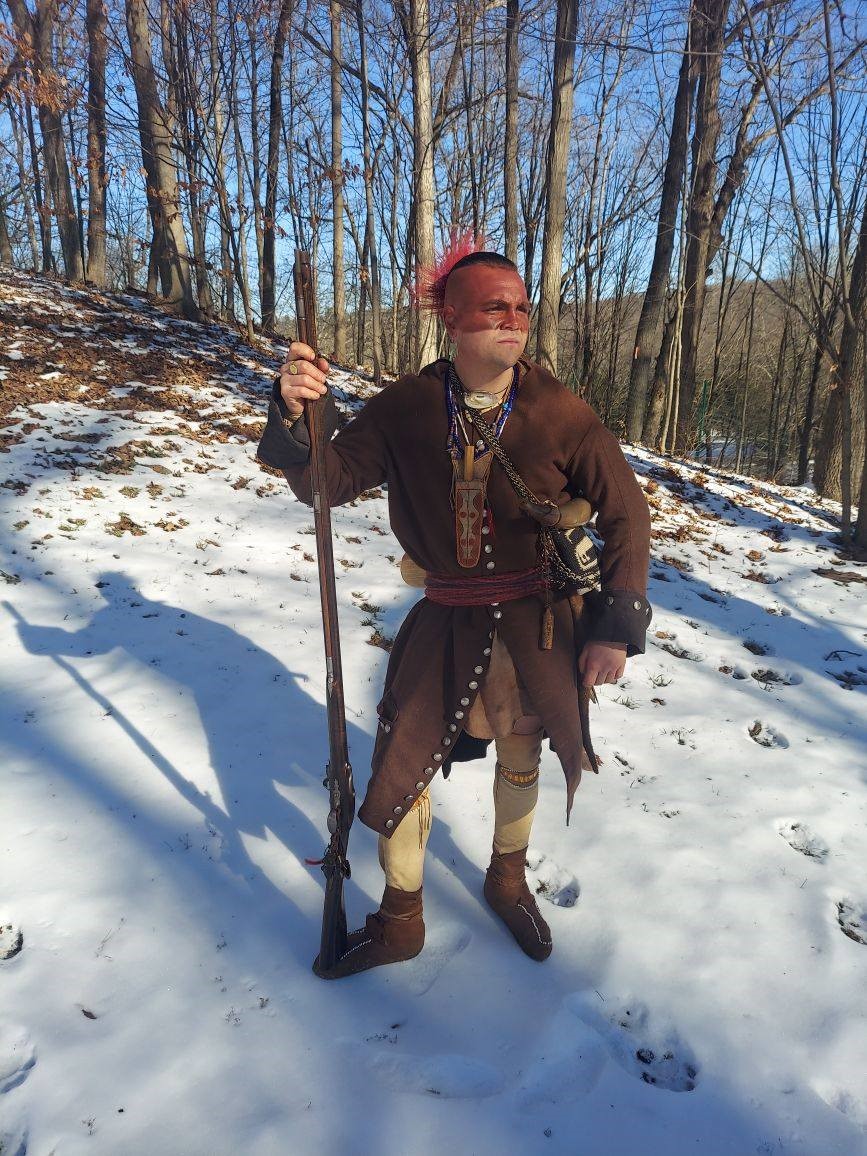
Drew Shuptar- Rayvis; Northern Cultural Ambassador of the Pocomoke Indian Nation and Algonkian Living Historian of the 17th and 18th century
Moccasins – For the Algonkian person, different shoes were worn for different times of the year. In summer around the village or on the coast, foot coverings may not have been worn and bare feet would have been more common. Moccasins (which literally means foot covering) were typically worn when traveling in unfamiliar territory all year round , summer included and during the fall and winter months.
There were two types of moccasins a thin ankle high summer moccasin and a taller lower calf to shin high fall/winter boot moccasin. All eastern woodland moccasins start out as a single piece of leather, typically deer skin , but elk skin is mentioned as well (The elk in question was the now the extinct eastern elk, Van Der Donck , Discovery of New Netherlands 1647, pg80). This leather which in a stepped process is stretched, scraped and then softened using animal brains and is then given a final stretch to break in the fibers and smoked , making the leather soft, durable and rot resistant is carefully shaped to the feet , by placing both feet on the leather and using the pointer and middle finger to trace around the feet till the middle ridge of the foot is reached in order to make sure enough space is given to each foot and that the shoe is not too tight, the cuffs are then cut where the middle ridge of the foot is.
Once the leather is traced and cut out (prior to Europeans, leather would have been cut with flint or chert, when Europeans arrive scissors and knives would have been used) it is then sewn. Sewing can be done in numerous ways, in the middle 17th century, punching holes with awls made of bone and then eventually European iron and sewing with thinly cut leather cord would have been most common, later in the 17th century, European needles largely replace the awl method. The summer moccasin is sewn first from the heel to the Achilles tendon, and then a central seam going up the middle of the foot, these seams can be sewn straight known as a center seam or can be folded forming a pucker, known as a pucker toe.
The winter moccasin is constructed identically to the summer moccasin with only two differences. The first is that the shoe is made slightly larger than the foot and is not supposed to be as fitted. This is because this shoe is meant to be filled with fur and later woolen moccasin inserts, these layers help keep the feet dry and warm in cold and inclement weather. The second difference is that the cuffs are much higher and the heel seam reaches all the way to the tops of the cuffs. (In a summer moccasin, the cuffs are generally 4 inches wide and 6-7 inches long, they drape over each side of the foot and have no seam holding them in place.) Once the heel seam is done, the next step is to cut long straps that attach to each tab of the cuff, these then cross the lower calf/shin and secure the shoe to the leg. This folding over of the cuffs prevents cold and snow from entering the foot. In some pairs of boot moccasins an extra piece of leather called a “vamp” is put in the middle of the shoe, the moccasin leather is sewn around the vamp which adds more space for the foot, the vamp then has a long tab that folds over the shin/calf and gets folded with the leather cuffs to make a better seal against cold and snow. Prior to Europeans, fur moccasin liners would have been constructed for boot moccasins. Furs that could have been used are beaver, raccoon, deer, bear, rabbit, these would add warmth and protection from the cold.
When Europeans arrive, Native Americans of Southern New Netherlands begin to trade for wool, particularly duffel (Rasiere). Duffel is a coarse, thick, woven woolen cloth that came in a variety of colors namely red, but in later accounts blue, purple and white are mentioned (Daniel Gookin 1674, Indian New England 1524-1674, Ronald Dale Karr, pg51). In New Netherlands, some natives had a particular preference for black duffel cloth as opposed to red or green which Isaac De Rasier said was “Because the wilden (Dutch word for Native Americans meaning wild people, pronounced vil den) say that it hinders them in hunting, as it is visible from too far off” (Jaap Jacobs 2009, Cornell University Press, The Colony of New Netherland , A Dutch Settlement in Seventeenth Century America, pg137.) the woolen moccasin liners would be cut out and sewn just like the leather ones.
Drew Shuptar- Rayvis; Northern Cultural Ambassador of the Pocomoke Indian Nation and Algonkian Living Historian of the 17th and 18th century

